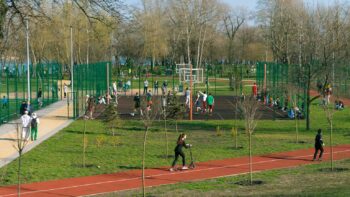Top 5 Government Technology Trends to Adopt Now
There is a prevalent misperception among the public that local governments operate entirely with manual, paper-based processes and outdated software. In reality, digital transformation leaders in our local government administrations are elevating the government-resident experience with modern technology, time-saving system integrations, and greater resident access to self-service solutions.
This article identifies five of the top trends in technology for government. It also offers practical insights related to public sector technology implementation.
Government Technology Trend #1: Data Sharing as a Program
While surfaced by Gartner in 2022 as a top government trend, data sharing as a program is more in vogue than ever for 2024 and beyond. Many local government agencies still limit access to data by systemically preserving data silos. This process undermines the efforts of government leaders seeking to maximize decision-making value from data and analytics — at a time when services are strained by increased public demand stemming from everything from exploding population growth to federal election cycles.
At the same time, demand for government transparency has skyrocketed to unprecedented levels, making ad-hoc public data-sharing practices wildly inefficient at best and antiquated public records request processes legally detrimental at worst.
What steps do local governments need to take to ensure the success of data sharing as a program? The most critical steps are cloud migration and data management.
Government technology trend #2: Cloud migration and data management
Cloud migration refers to moving applications and data partially or wholly into the cloud — or from one cloud to another. Secure, cloud-based data management offers local government agencies significant cost savings by reducing the amount of on-site supplies, equipment, and real estate required to support paper-based processes, legacy systems, and on-premise servers.
Cloud-based technology solutions are pivotal in empowering asynchronous collaboration and cross-platform connectivity essential for streamlining workflows, especially in today’s hybrid work environments. Cloud-based tools allow team members to collaborate at different times, accommodating various time zones and work schedules. This flexibility means that work can progress without requiring all participants to be online simultaneously.
These solutions also provide seamless integration across different platforms and devices, enabling team members to access work-related files and applications from anywhere, on any device. This connectivity ensures that workflows are not disrupted when switching between devices or when team members are on the move. By centralizing data and applications in the cloud, these technologies reduce the need for repetitive tasks and manual data transfers, leading to more efficient processes.
Government Technology Trend #3: Total Experience
In a total experience model, traditionally siloed and disjointed customer experience (CX), employee experience (EX), multi-experience (MX), and user experience (UX) disciplines are connected in support of government transformation. According to Gartner, by 2026, government total experience approaches will reduce process ambiguity by 90% while increasing satisfaction metrics for both CX and EX by 50%.
To gain a deeper understanding of what an optimized total experience might look like for a local government agency, consider the pivotal role connected technology solutions play in the following entirely plausible yet ultimately fictional scenario related to code enforcement:
A city resident noticed that the grass in the yard across from their home was not mowed. The resident was concerned, knowing that only a year before and a few blocks down from them, a grass fire during the heat of the summer spread and burned down a detached garage as the result of a prohibited outdoor burning event. The resident was not well-informed about the issue but had a logon to a portal where they could search the online code of ordinances for “grass and weeds.” The online search functionality made it easy for the resident to find a code section that discussed how having noxious weeds and grass exceeding 10 inches was prohibited. The resident watched the property over the next few days to see if the grass would be cut before it grew to exceed the 10-inch limit.
A few days passed, and the neighbor’s uncut grass grew taller than the limit. The resident recalled seeing a “Submit Request” button near the online code of ordinances and decided to return to the portal via mobile device. Upon selecting “Submit Request,” the resident was presented with a map to choose a location. The resident typed in the street address for the property across the way. The software found the address and invited the resident to denote the appropriate tall grass and weeds category. The resident even took and submitted a picture of the property and their request. A few moments later, the resident received an email from the city with a complaint number and details about the next steps.
While a code enforcement officer was visiting with a resident about a noise issue, they received an alert via a mobile app that a complaint about tall grass had been submitted via the city’s 311 CRM software portal. The nearby officer decided to drive over and evaluate the complaint to make the best use of their time. When the officer observed the lawn to exceed the length allowed by the code of ordinances, he changed the status and elevated the complaint to an enforceable violation. The officer opened an inspection event via the app, which allowed them to take pictures and insert specific references from the code of ordinances. The officer also noted the property had a “for sale” sign and included the real estate broker represented on the sign in the property record. The officer created a notice of violation, which included representative photos, and sent the document by certified mail to the owner associated with the digital property record, which they could view from the inspection. The officer changed the status and scheduled a return inspection for seven days from the date of notice based on the guidelines in the code of ordinances. When the code officer changed the status of the complaint, the resident who submitted the concern was updated automatically by the 311 CRM software and felt satisfied that someone was addressing the issue.
After completing the tall grass and weeds inspection, the officer drove a few blocks south and viewed a residential home with peeling paint and a roof with missing shingles. The officer isolated the parcel using their mobile device, the geographic information systems (GIS), and the mapping viewer within the app. The parcel record showed that the property had recently changed ownership. From the parcel record, the officer began enforcement by creating a violation and performing an inspection. The mobile inspection feature allowed the officer to take pictures of the exterior paint and roof. The officer added supporting references because the app was connected to the International Property Maintenance Code (IPMC) and the city’s online code of ordinances. Upon inspection completion, the app automatically created a notice of violation, including the code references, resolution dates, and representative pictures. The notice of violation referenced the code of ordinances stating that the owner had a responsibility to repair or the ability to appeal.
A week had passed since the notice of violation had been sent to the property with tall grass. Because the officer had set a return inspection, the mobile app alerted them that it was due today. The officer drove to the property and discovered that the lawn had been mowed and a dead tree had also been removed. The officer completed an inspection by taking pictures and changing the issue’s status to close. The change in status caused an automatic message to be sent to the resident who had reported the issue, letting them know that enforcement action was now completed.
On the same day, the officer’s mobile app let them know it was time to return to the home down the street with peeling paint and a roof in disrepair. The officer observed that no communication had been received from the owner, and no repairs had been made. The officer completed the inspection by taking pictures and noting that a few front windows were also broken. The officer sent a message to the police via the app, alerting them to a potential blight property that might have illegal activity within. The officer once again referenced the code of ordinances for the next steps, which detailed that a notice to appear was required. The officer created a citation ticket and hearing date within the app, which generated a notice to appear document. The officer set a follow-up action step and inspection event for the day before the appearance. The notice was delivered by certified mail and recorded in the app.
The officer logged into the app at the hearing and opened the violation record. The owner’s son was present, and the judge asked the officer to provide the summary document that was prepared by the app, which included all actions, inspections, codes violated, and photographs. The judge cited the online code of ordinances and ordered the owner to apply for permits to repair the roof within five business days of the court date. During the proceedings, it was noted that the owner was the son of a long-time city resident recently admitted to a long-term care facility. Therefore, little funding was available to care for the home. The code officer made note of the proceedings in the app and then issued a hearing order document to the owner. The owner’s son was informed of a portal within the city’s website where they could find an online application option.
The son did not want the issue to progress and wanted to care for the home in a manner that reflected the good reputation of his mother. The son lived a few hours away but was able to apply from the online portal mentioned in the hearing order. The application for a re-roof permit was submitted online by completing the form, identifying contractors, and paying a fee. When the building department received the online application, they could view the code enforcement action associated with the property. This documentation allowed them to keep the officer apprised that a new roof had been installed and the inspections had been passed. The code officer closed the violation issue related to the roof and reached an agreement on the peeling paint for the following spring.
Long story short: To effectively realize the benefits of an optimized total experience, local government agencies must ramp up modernization to accelerate the transition to digital government.
Government Technology Trend #4: Digital Government
Digital government is the administrative process of delivering government services to the public through digital technology. These services can range from filling out online forms to searching local government agency websites for codes of ordinances.
Example workflow
Following is an infographic depicting an example of a digital government service workflow related to community development:
The benefits of the above digital government workflow include:
- Increased speed and accuracy: Decreases processing times for permits, complaints, and more while eliminating duplicative, error-prone work.
- Reduced costs: Lowers operational expenses by automating manual tasks and optimizing resource allocation.
- Improved community engagement: Connects communication channels and provides online service portals for residents, promoting local government transparency and trust while alleviating agency staff workload.
- Enhanced safety and compliance: Helps ensure standards and codes of ordinances are met, contributing to the overall safety and well-being of the community.
- Sustainable growth: Supports community development at scale through efficient, safe, and compliant planning and building practices.
- True cross-department collaboration: Facilitates seamless information sharing across departments, improving service delivery and decision-making.
Government Technology Trend #5: Integration
Integration is the foundation upon which the success of the above government technology trends of data sharing as a program, cloud migration and data management, total experience, and digital government reside. Local governments across the country are dealing with the harmful effects of fragmented processes. Having manual workflows for essential community safety and development functions, such as receiving resident requests or planning, permitting, licensing, and inspections, slows down community development. It also increases the potential for safety hazards. However, relying on multiple vendors to execute these functions creates friction and frustration, underscoring the need for a unified technology suite.
Agencies need to implement modern, streamlined solutions to function more effectively in the modern world. With integrated software for government websites, community development, resident requests, municipal codes, and mass notifications, CivicPlus enables safer, more compliant communities poised for growth. Contact CivicPlus to learn more.


